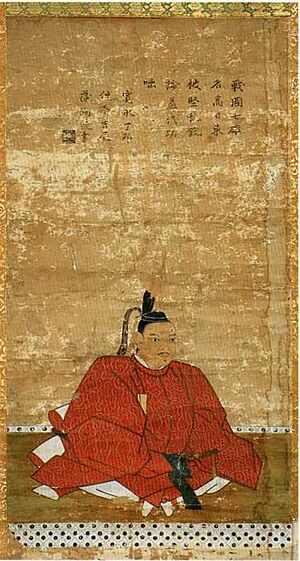Wakisaka Yasuharu facts for kids
Quick facts for kids
Wakisaka Yasuharu
|
|
|---|---|
| 脇坂 安治 | |

Wakisaka Yasuharu
|
|
| Lord of Awaji Island | |
| In office 1585–1626 |
|
| Succeeded by | Wakisaka Yasumoto |
| Personal details | |
| Born | 1554 Nagahama, Shiga, Japan |
| Died | September 26, 1626 (aged 71–72) |
| Military service | |
| Allegiance | |
| Battles/wars | Tanba Campaign Siege of Miki Tenshō Iga War Battle of Shizugatake Kyūshū campaign Odawara campaign Korean campaign Battle of Sekigahara |
Wakisaka Yasuharu (born in 1554, died in 1626) was a powerful Japanese warlord, known as a daimyō. A daimyō was a feudal lord who ruled over a large area of land. He lived during Japan's Sengoku period, a time of many wars and changes.
Wakisaka Yasuharu fought for different leaders throughout his life. He was known for his skill and bravery in many battles. He was especially good at naval (sea) combat.
Contents
Early Life and Service
Wakisaka Yasuharu first served a lord named Azai Nagamasa. But in 1573, Azai Nagamasa was defeated. After this, Wakisaka Yasuharu joined the Oda clan.
He became a yoriki, which means a helper or assistant, to Akechi Mitsuhide. Akechi Mitsuhide was a trusted follower of Oda Nobunaga, a very powerful leader. Wakisaka Yasuharu showed his bravery in 1578 during a fight at Kuroi Castle.
Joining Toyotomi Hideyoshi
Later, Wakisaka Yasuharu decided to work directly for Toyotomi Hideyoshi. Hideyoshi was another very important leader in Japan. Wakisaka Yasuharu became even more successful during Hideyoshi's campaigns in the Chugoku region. He helped in attacks on Kanki Castle and Miki Castle.
In 1581, he also took part in the Tenshō Iga War. He was one of the generals who led Nobunaga's soldiers in the Siege of Hijiyama.
The Seven Spears of Shizugatake
In 1582, Akechi Mitsuhide turned against Oda Nobunaga. But Akechi was defeated soon after. Wakisaka Yasuharu then joined Toyotomi Hideyoshi, who had become a very important figure.
After the Battle of Shizugatake in 1583, Wakisaka Yasuharu became known as one of the shichi-hon-yari, or Seven Spears of Shizugatake. These seven warriors were among Hideyoshi's most trusted generals. They were especially good at fighting on the sea.
In 1585, Wakisaka Yasuharu was given control of Awaji Island. This land was worth 30,000 koku, which was a way to measure the value of land based on how much rice it could produce.
He then became a commander in Hideyoshi's navy. He took part in Hideyoshi's campaigns in Kyūshū in 1587. He also fought in the Siege of Odawara in 1590.
Korean Campaigns
From 1592 to 1598, Japan launched invasions of Korea. Wakisaka Yasuharu played a big part in these campaigns.
In 1592, Wakisaka led 1,500 soldiers to the Korean peninsula. He faced a major defeat by Admiral Yi Sun-shin at the Battle of Hansando. He lost most of his ships. Wakisaka barely survived and hid on a nearby island, eating seaweed until the enemy left.
He fought in many battles on land and sea in Korea. In 1597, he led a fleet of 1,200 men. He destroyed a Korean fleet led by Won Gyun during a counterattack.
Even with his efforts, he could not stop Admiral Yi Sun-shin. Yi Sun-shin's naval actions cut off Japan's supply lines to Korea. This made it very hard for the Japanese forces to get food and weapons. Despite the overall Japanese defeat in these wars, Wakisaka's land was increased by 3,000 koku as a reward.
Battle of Sekigahara
In 1600, a very important battle took place called the Battle of Sekigahara. This battle decided who would rule Japan. Wakisaka Yasuharu was planning to join Tokugawa Ieyasu, one of the main leaders. However, he was forced to join the other side, led by Ishida Mitsunari.
On October 21, during the battle, Wakisaka Yasuharu changed sides. He joined Tokugawa Ieyasu, along with another general named Kobayakawa Hideaki. Wakisaka's forces helped defeat Ōtani Yoshitsugu's army. This helped Tokugawa Ieyasu win the battle.
After the battle, Tokugawa Ieyasu allowed Wakisaka Yasuharu to keep his land on Awaji Island. Later, he was given another area of land in Iyo Province, worth 53,000 koku.
Wakisaka Yasuharu died in 1626. His son, Wakisaka Yasumoto, took over his family's leadership.
See also
 In Spanish: Wakizaka Yasuharu para niños
In Spanish: Wakizaka Yasuharu para niños

